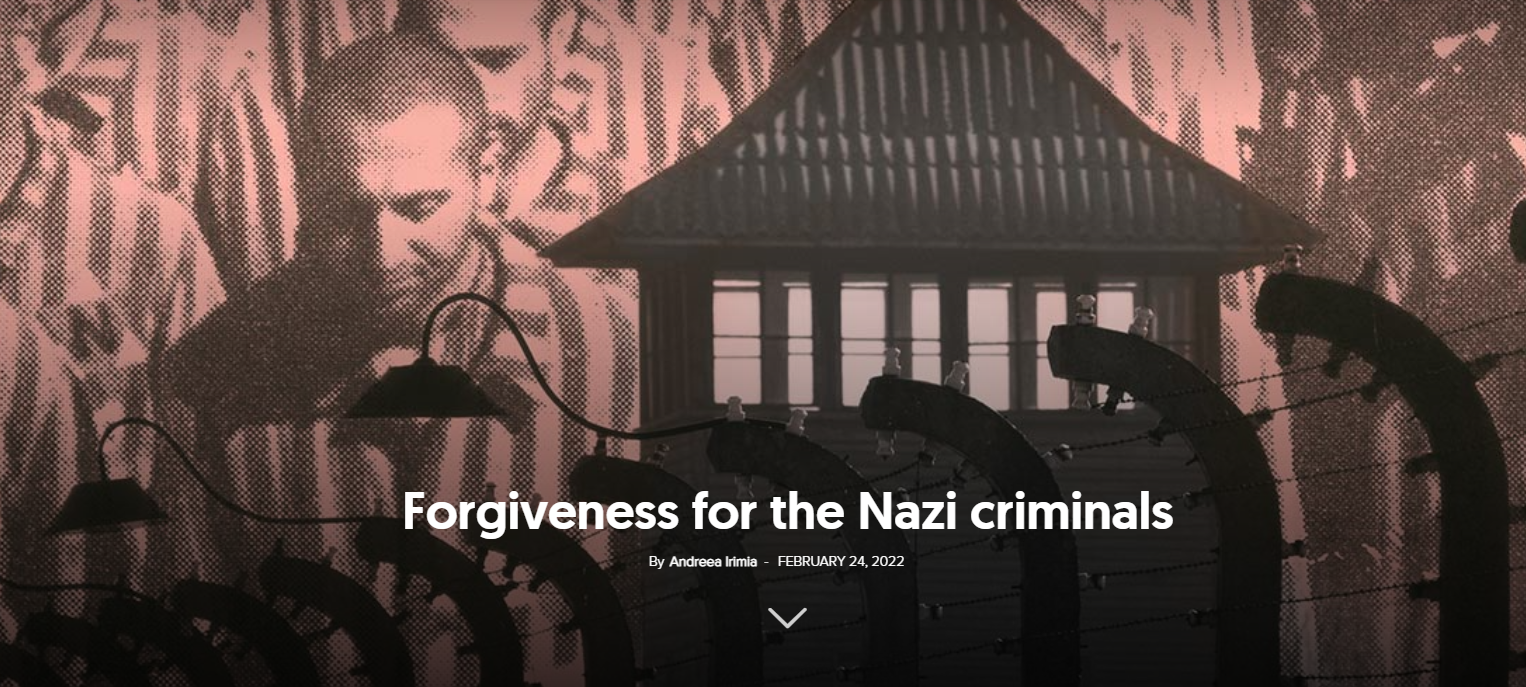“Forgiveness is the sweetest revenge.” (Jerome Isaac Friedman)
We carry in the pockets of our hearts fragments of time, memories of the past, drying out in the breeze of past emotions. We sometimes browse through them, after the children have gone to bed, feeling again with our soul the places and faces of that time. Some are rough, others are delicate and fine, laced with love on both sides. Sometimes we go too deep, breaking our soul into shards of regret, sharpened by pain and trouble.
No matter how many years we wrap around them, their edge cuts through from the past to the present, slashing our thoughts once again, robbing us of kindness, leaving us devoid of goodness and beauty. Only forgiveness can glue our pieces back together, making us whole again, and able to love once more without regret and without holding anything back.
Forgiveness has become an almost archaic virtue, which, by the time it reaches us, shrinks to an expression of helplessness or exasperation: “I have forgiven you once, twice, but enough is enough.” Using excuses, we create all kinds of definitions to suit our own circumstances.
Some psychologists say: “Forgiveness involves a willingness to abandon one’s right to resentment, negative judgement, and negative behaviour toward an offender, while fostering the undeserved qualities of compassion, empathy, and goodwill toward one’s offender.”[1] However, in practice, forgiveness comes in an infinity of shades. In the second part of his book The Sunflower, Simon Wiesenthal presents dozens of definitions of forgiveness in the context of the Holocaust from various spiritual perspectives.
On the brighter side of the spectrum, Theodore Hesburgh, a Catholic priest and educator, said that he would forgive anyone for anything if they asked for forgiveness, because God forgives. The Dalai Lama, the Buddhist spiritual leader, replied that he would forgive but not forget the atrocities committed. Dennis Prager, who describes himself as a religious Jew, expressed that the sin of murder could never be forgiven because the only person who could forgive is no longer alive.
At the opposite end of the spectrum, Sidney Shachnow, one of the survivors of the Holocaust, completely refuses to forgive the SS officers, arguing that some atrocities can in no way be forgiven.[2]
What follows from these perspectives is that forgiveness can also be defined by what it does not do—it does not erase the offence or the pain caused; it does not justify, but on the contrary, names the evil and asks the one who committed it to bear the consequences of their action. Especially in cases of abuse, forgiveness should never seal a reconciliation that leads to the perpetuation of the original evil.
Everett Worthington sees Nazi atrocities from a different angle. In his book, he presents the reaction of Yehiel Dinur, a Holocaust survivor who was a witness during the trial of the infamous Nazi war criminal, Adolf Eichmann. Face to face with Eichmann, Dinur sees himself and behind him all of humanity.
He sees the evil smouldering in each of us, ready to take over our being, if the circumstances allow it. “Eichmann is in each of us,” says Dinur, horrified. The moral distance between us and the monsters that torment us could be much smaller than we imagined. This understanding can make forgiveness easier to swallow.
“Beware that, when fighting monsters, you yourself do not become a monster.” (Friederich Nietzsche)
The monstrosity of evil is contagious. The German philosopher Friederich Nietzsche warned us of the danger of approaching evil when following it closely in our thoughts and deeds. It can turn us into monsters at any time. Similarly, the apostle Paul assures us that the pursuit of good is also contagious. Looking at God, we are reshaped into His image. Beholding the glory of the Lord, we “are being transformed into his image” (2 Corinthians 3:18). Jacob wrestled with God, and God let him gain a better and more heaven-worthy character (Genesis 32).
The touch of evil and the effects of the transformation it produces are extremely costly. It costs us our peace, love, mercy, the feeling of security, family, and friendships, and last but not least, the belief in a better and fairer world.[3] God’s touch and the transformation into His image is a regenerating process. We begin by emptying our souls of anxieties and depressions, of fears and anger.
Jesus collects them all, seventy-seven times, and then He fills our bags with faith, optimism, and self-control. He heals us from the nightmares of the past and strengthens our remaining days in a stronger and more vigorous body. And that’s not all. The healing forgiveness brings will also extend to those who have wronged us. According to author Jean Hampton, forgiveness offered to an evildoer can separate evil from its doer, having the power to heal their rebellion against good and soften their hardened heart.[4]
“To err is human, to forgive divine.” (Alexander Pope)
On October 2, 2006, Charles Carl Roberts IV went to the small school in the town of Nickel Mines, Pennsylvania, and shot ten Amish girls in the head, all between the ages of 6 and 13, before killing himself. Inexplicable and unexpected. The world was shocked by the contrast between the pastoral image of the Amish community and the unprovoked violence of the incident.
Beyond the darkness of the tragedy, however, the Amish community managed to rise above the earthly, offering forgiveness to the killer and his family, just hours after the morbid event. Forgiveness was first expressed in warm words and tight hugs which then turned into deeds—Amish families attended the murderer’s funeral in large numbers and later provided financial support to the Roberts widow and to the three children who became fatherless.
Many have marvelled at the power of Amish Christians to forgive, even though over two billion people learn about forgiveness from the same Christian Scriptures. Unfortunately, for many Christians, the offer of forgiveness has conditions, demands, and is capricious. Today it is extended, tomorrow withdrawn.
The members of the Amish community forgave without thinking too much, without consulting with each other. They forgave because that’s what they were taught as little children, when they learned by heart “…and forgive us our debts, as we also have forgiven our debtors” (Matthew 6:12). They forgave in order to be forgiven in their turn. For them, forgiveness was the first step to healing.
Journalists wondered if their forgiveness was genuine, wise enough, and permanent, but above all healthy, considering the ease and speed with which it had been offered. The explanation lies in the Amish moral repertoire. Among them, tragedies are accepted without question or doubt, because they know those tragedies come from the hand of a loving God.
The calamities suffered are permitted by God with the promise of a future rich in fruit in the souls of faithful people. Final justice belongs to Him alone. Therefore, tragedies can only be understood through forgiveness in the Amish community. The forgiveness that is offered takes them closer to heaven, heals them from the worldly, and reconciles them with God.[5]
The Amish families had forgiven then, and they still forgive today, because forgiveness never ends. Psychologist Everett Worthington divides forgiveness into two temporal sequences. The first, the short-term or immediate forgiveness, is a decision not to get back at the evildoer. The decision to forgive leads in time to actions, at first small and clumsy, such as a simple smile or a warm look.
However, these small gestures, practised repeatedly, will grow, turning over time into a handshake, a phone call, a meeting, so that, in the end, they give rise to positive emotions towards the one who has wronged us. This last phase is the emotional forgiveness, which can take years to set in and lasts for the rest of your life.[6]
“Forgiveness is the fragrance that the violet sheds on the heel that has crushed it.” (Mark Twain)
The soul crushed by evil will forever be stained with tears. Nevertheless, each of us chooses how we want to remember what we cannot forget: climbing closer to heaven—forgiving—or crawling through the world, carrying our misdeeds with us. Jesus is standing next to us, ready to teach us how to count forgiveness. First out loud, then to ourselves. Once, twice, thrice…, until we learn to go beyond four hundred and ninety times (Matthew 18:22).
Denisa Selagea confesses that she is still learning to count forgiveness in two and three digits, even though during her college years she was a mathematics tutor. This is because this kind of counting cannot be learned from textbooks, but is experienced page by page, throughout life.




















